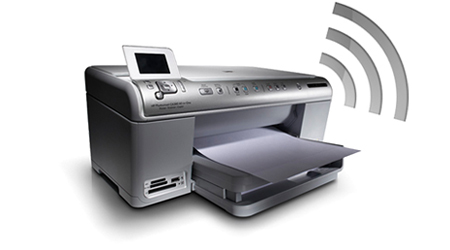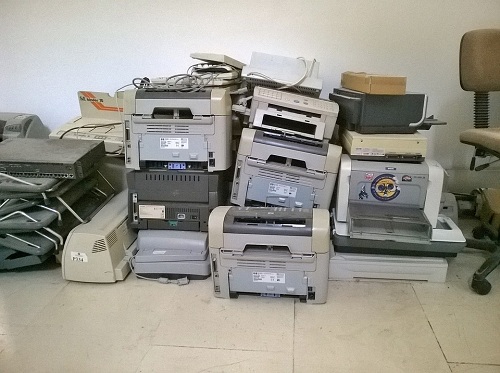A Guide to Understanding How Wireless Printers Work

The faster technology progresses, the easier it is to forget the inconveniences of the past. Those who buy the newest smartphones may be frustrated that their old cord headphones no longer work with the new model without bulky adapters, but soon there will be a day when few will recall that headphones once required cords at all.
Printers, too, have progressed quickly from the loud, slow, and frustrating machines they once were. Today, most printers can print in monochrome or color, they can function as multiple devices—like as copiers, scanners, and fax machines—and some can even connect to the internet.
Printers are still an important part of most offices and businesses, but they’ve always had one limitation: a messy tangle of cords. Read this guide to learn how wireless printers work and, with new models of wireless printers emerging, why cords are becoming a thing of the past.
How Wireless Printers Work
Increasingly, technology is enabling people to move away from the use of physical connections, allowing more flexibility for users. Everything from headphones to smartwatches and laptops is adapting wireless connectivity. Sending and receiving messages is at the core of how these technologies work.
A printer—similar to headphones or computers—requires a signal from an exterior device, sending it a message. This message indicates how to print a document, graphic, or picture and is the basis of how wireless printers work. In the past, the process required cords; today, it can be done wirelessly. Like most other devices, printers accomplish this through one of two methods: a WiFi network or Bluetooth.
One of the most common technologies enabling wireless printing is WiFi network connectivity. Just like how a laptop or cellphone connects to the internet through a router, a printer can connect to that router as well. This technology is easy to use and offers fast connection speeds. Some printers can even send and receive emails, thanks to WiFi connectivity.
The other common method for sending printers files to print is called Bluetooth. Invented by the Ericsson telecommunications company, Bluetooth uses special radio waves to transmit data. Unlike WiFi-connected printers, Bluetooth-enabled printers can connect directly to devices. Bluetooth is becoming increasingly more common in devices like headphones and smartwatches.
Given the rise of smartphones and tablets, having to have a physical connection between devices is becoming increasingly archaic. The way wireless printers work today is much more in line with contemporary technology.
The Benefits of Going Wireless

One of the main benefits of going wireless is that it allows more devices to connect to printers. Thanks to wireless technology, smartphones, laptops, tablets, desktop computers, and other devices can all connect to printers. Just imagine having to plug an ethernet cable into a smartphone!
Another benefit of wireless connectivity is that it allows devices to move about freely without being tied down with cumbersome cords. The cords and routers needed to connect multiple devices to previous generations of printers added to the clutter of an office and dictated how people needed to arrange an office to begin with. By going cordless, a business could save time, money, and space.
One of the other reasons why going cordless is helpful is that it solves the problem of obsolete cord and wire systems. Previously, anyone who wanted to upgrade their wired devices had to consider if the new devices will be able to connect to the old printer. With wireless connectivity, on the other hand, connecting to a printer is possible with any brand, operating system, or format.
Wireless Printers: Budgeting for New Technology
Keeping up with changing technology can seem burdensome, but some investments are wiser than others. Gambling on untested technologies can be a risky endeavor, especially for people who may not know how wireless printers work. Luckily, the technologies that enable wireless printing have been tested, are efficient, and will likely be in use for years to come, making wireless printers a stable investment.
As more devices become wireless, the reasons for buying a wireless printer mount. Many printers are now offering wireless features standard or as an optional upgrade. For anyone considering whether or not going wireless is necessary, it’s important to note that what is an investment now will be standard in the future. Making the upgrade will make printing easier and will give your printer longevity.
Who Should Buy a Wireless Printer?
In a few years, it’s likely that cords and cables will be almost entirely obsolete. For this reason, anyone who is considering buying a printer in the near future should think about upgrading to wireless. Because the wireless technology only affects how wireless printers work in regards to sending and receiving messages, you can still select from among the several types of printer currently on the market, such as inkjet and laserjet printers.
Depending on what make and model of printer they need—Canon, Lexmark, or any other brand—you may need to budget extra money for wireless capability. Unless the computer you connect to the printer is so old that it support wireless connectivity, going wireless is an extremely helpful choice.
Consider the Future
Once you have a printer, buying ink will become an important part of maintenance, so upgrade your ink supplier to the most efficient source. You’ll need a supplier that can provide ink and toner cartridges for multiple brands at great prices, so that your printer can function at optimal levels while also saving you money. At 1ink.com, we are proud to present the lowest prices on the highest quality ink and toner cartridges available online.
If you enjoyed this information about wireless printers, explore the 1ink.com blog to learn about printers, ink and toner cartridges, and more.
